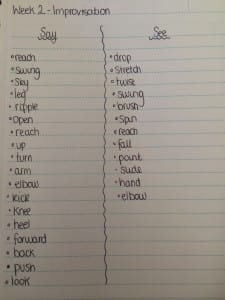This week, the readings were about form, attention and intention. With the said readings in mind, I ensured that I paid close attention to these aspects when improvising in class.
We took part in various exercises in class, but the one that interested and challenged me the most was the ‘continue, develop, change’ task. We first had to do this as a soloist. Moving around the room we had to improvise movement, which we could then continue, develop or change. I found this challenging, as after a while I ran out of movements that I could easily develop. I found that changing and continuing the movement was not as difficult as you could change it to anything, or continue one specific movement. However, after a while I felt that I ran out of movements that I had not already used within this task, so it became increasingly difficult to continue, change or develop. Because there was no specific intention to the movement that I was doing, I felt that the task was more challenging. Therefore, if I had a specific intention that I wanted to apply to my movement, I may have found it easier to complete this task.
Another task that I found useful in relation to attention was leading an improvisation with a specific body part. Drawing attention to one specific body part helped me to find new and interesting movement. As well as this, attending to one body part made it easier to continue, change and develop the movement, as you could pay particular attention to that one area, exploring every possible movement, which could be achieved in this area.
In Kent De Spain’s book ‘Landscape of the Now’, he talks about attention as:
“The ability to sense how the movements in the present moment relate to the movements that have come before, to feel them in space and time, to connect them to the movements of others.” (De Spain, 2014, 167).
I found that this quote really helped me to explore my body and movement closely when leading with a specific body part. It helped me to connect the movements that I had done previously, with any movement that it could lead too. It also allowed me to connect the movement with the space around me. I began to use a wider area of the performance space, enabling me to use bigger and more varied movements. As I became more and more involved and comfortable within this task, I found that this allowed me to think of an intention that could drive my movement. This again helped me to link the movements previous to the ones that I was doing in the moment.

Questions which arose after discussing the readings on Form, Intention and Attention.
In relation to these questions, I found myself thinking about how I use form, attention and intention in my own improvisations. In ‘Composing while Dancing’, by Buckwalter, she says:
“There are many different ways to consider form in dance… the shape of the body in movement, arrangement of bodies in space, or the shape of the body in time.”(Buckwalter, 2010, 34).
This made me think about how I used the space in my improvisations. I found that I often did not explore a lot of the space, and instead I only use either a strip or small area whilst dancing. So, when I come to the improvising class next week, I will push myself to the limits of the space.
As well as this, I will make sure that I distinguish between Attention and Awareness when improvising. Kent De Spain in ‘Landscape of the Now’, explains attention as “a telephoto lens,” and awareness as a “wide angle.”(De Spain, 2014, 68). This means that attention is focusing on one specific thing, whilst awareness is focusing on everything around you as well as the specific thing. In the next class, I will make sure that I focus on everything in the space as well as my movements, as I often lose focus on my form.

The score used in our improvisation jam that focused on attention, form and intention.
This weeks improvisation jam really opened my eyes as to how space can affect movement and spacial pathways. Only having a small space to work in really limited the pathways and size of the movements you could do. From taking part in this score, I found that different relationships can form both intentionally and unintentionally. When observing from the side, I noticed that at times people would create duets, trios and quartets without realising. I found this really interesting, how people had no idea that they were involved in these relationships. However, unintentional relationships often appeared as more interesting and intriguing, as they would not copy the other person, which often happened a lot with intentional relationships.
Buckwalter, M. (2010) Composing while dancing: An Improviser’s Companion. Madison, WI, USA: The University of Wisconsin Press.
De Spain, K. (2014) Landscape of the Now. New York, NY, USA: Oxford University Press.





Recent Comments